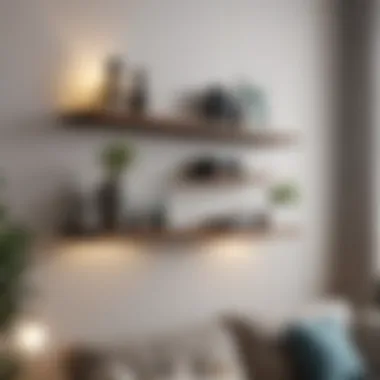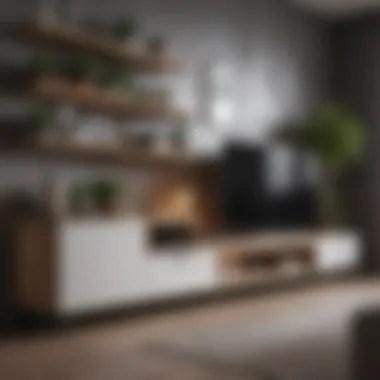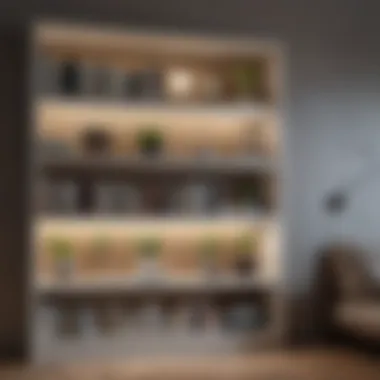Innovative Shelving Ideas for Small Spaces


Intro
Navigating the complexities of living in small spaces is a challenge many face. Often, homeowners, interior design enthusiasts, and those who appreciate organization find themselves seeking effective ways to utilize every inch of space. This article presents a detailed exploration of innovative shelving solutions designed specifically for compact environments. By considering vertical space and multifunctional options, individuals can enhance both aesthetic appeal and organization.
In this guide, we will discuss critical aspects like trending styles in shelving, effective color palettes, and practical maintenance insights. These topics will unpack how to create a harmonious space that reflects personal style without sacrificing functionality.
Design Inspirations
Trending Styles
When it comes to shelving in small spaces, style and functionality should complement each other. Open shelving is one popular option that lends an airy feel to tight environments. Materials like wood and metal blend well to create an industrial edge, while softer, curved shapes offer warmth. Floating shelves are another hot trend, providing an unobtrusive way to display art or store essentials without taking up floor space.
Another option gaining traction is modular shelving. This solution allows for customization and adaptability. Homeowners can easily adjust to changes in their needs or style preferences. Incorporating innovative storage solutions, like bookshelves that double as room dividers, blend function with aesthetic appeal effectively.
Color Palettes
Choosing the right color scheme is crucial when selecting shelving options. Lighter shades, such as whites or soft pastels, can brighten up a small area, creating an illusion of more space. Alternatively, bold colors can be used strategically to create visual interest, particularly for accent shelves.
"Color can dramatically affect perception of space. Choose wisely to enhance dimensions in small living areas."
Neutral tones can serve as a base, allowing for easy integration with various decor styles. Consider utilizing pops of color through decor items on the shelves, rather than the shelves themselves. This method keeps the focus on organization while making the space visually engaging.
Maintenance and Upkeep
Seasonal Maintenance Checklist
Maintaining shelving in small spaces is just as important as the initial selection. Regular inspection is necessary to ensure structural integrity. A seasonal checklist can help you stay organized and proactive:
- Check for any signs of wear on brackets or supports.
- Dust shelves regularly to prevent buildup that can make spaces feel cluttered.
- Rearrange items to refresh the look and ensure efficient use of space.
Cleaning and Organization Tips
Cleaning and organizing shelves can enhance both their functionality and visual charm. Use gentle cleaners for wood and metal surfaces to avoid damage. A soft cloth will keep surfaces shiny and free from scratches.
To maintain organization, consider categorizing items by type or color. This strategy not only increases efficiency but also adds a sense of cohesion to the space. Invest in small baskets or boxes for loose items, providing a tidy appearance while offering easy access.
By implementing these design inspirations and maintenance strategies, small space living can transform into a well-organized, stylish haven.
Understanding the Challenges of Small Spaces
Living in a small space can be both a blessing and a burden. The focus on understanding the challenges of small spaces is essential for anyone looking to maximize functionality and aesthetics in their homes. Limited square footage poses unique problems, but recognizing these challenges can lead to effective solutions.
Common Issues Faced in Limited Areas
Common issues in small living areas include clutter, poor organization, and lack of versatility. These challenges often stem from not having enough dedicated storage or insufficient furniture layout. Ineffective organization can lead to frustration, impacting daily life. People in small homes may find themselves overwhelmed by their belongings, leading to disarray. For instance, consider the problem of overcrowded surfaces; without appropriate shelving, essentials can clutter counters and tables.
- Clutter: This is one of the most immediate concerns. Limited storage options can lead to a collection of items that disrupt the flow of a living area.
- Accessibility: Frequently used items may become buried beneath others, making it laborious to retrieve them.
- Aesthetics: A lack of intelligent design can create a chaotic visual environment, negatively affecting mood and comfort.
Addressing these issues is critical to creating an organized life in confined spaces.
The Importance of Smart Design
Smart design plays a pivotal role in how well small spaces work. It incorporates functionality into style, ensuring that every inch is utilized effectively. When designing for small areas, consideration of layout and furniture choice becomes paramount.
A thoughtful approach to design means choosing pieces that serve multiple purposes. For example, a coffee table with storage can eliminate clutter while providing a central gathering point. Likewise, modular furniture allows homeowners to adapt their setup as needed.
Incorporating attractive shelving can easily help save ground space while keeping items within arm’s reach. A well-designed shelving system not only enhances storage capacity but contributes to the overall decor.
Smart design helps transform limitations into distinct advantages.
Thus, understanding the challenges of small spaces leads to more innovative and practical solutions that facilitate not just living, but thriving in a compact environment.
The Role of Shelving in Space Optimization


Shelving is a crucial factor in enhancing the functionality of small spaces. In homes or offices with limited square footage, every inch counts. Therefore, incorporating intelligent shelving solutions can dramatically improve both storage and aesthetics. The right shelves not only keep spaces organized but also add to the decor without overwhelming the area.
Why Shelves Are Key to Small Space Design
In the struggle for maximizing utility in confined areas, shelves emerge as effective tools. They enable homeowners to utilize otherwise wasted vertical space. By extending upward, shelves create an illusion of height, making rooms feel larger and more open. Furthermore, they are versatile. You can find shelves in various styles, ranging from elegant wooden designs to modern metal structures. This flexibility allows them to blend seamlessly with existing decor, enhancing the overall interior design.
Moreover, shelves provide practical storage solutions. They allow homeowners to keep items accessible while maintaining a tidy environment. For instance, installing floating shelves in a living room can showcase books or decorative objects, transforming them into focal points. In kitchens, wall-mounted shelves help in organizing utensils and ingredients. The benefits are clear: shelves organize, display, and optimize space all at once.
Maximizing Vertical Space
Maximizing vertical space is vital when dealing with small areas. Traditional horizontal furniture often consumes too much floor space, which can quickly lead to a cramped feel. In contrast, tall bookshelves or wall shelves draw the eye upward. This approach not only provides additional storage but also helps create an airy atmosphere.
To fully leverage vertical space, consider the following tips:
- Install shelves at varying heights. This creates interest and adapts to different item sizes.
- Use corner spaces. Corner shelving units can be especially effective, turning often-overlooked areas into valuable storage.
- Incorporate adjustable shelves to accommodate different needs over time. This adaptability is particularly useful in multi-functional spaces.
"The key to designing effective small spaces lies in understanding how to make the most of the vertical. Shelving solutions allow for increased storage while preserving floor area."
Types of Shelving Solutions
Understanding different types of shelving solutions is vital for maximizing space in small areas. Each shelving type offers distinct advantages and varies in design, functionality, and usability. By considering these options, one can make informed decisions about how best to organize and decorate limited spaces effectively.
Wall-Mounted Shelves
Wall-mounted shelves stand out for their ability to save floor space while providing significant storage. They help to declutter and create a sense of openness, essential in any small area. These shelves can complement various styles of decor, adding character without taking up valuable real estate.
Floating Shelves
Floating shelves are a favored choice due to their minimalistic design. These shelves attach directly to the wall, creating the illusion that they are suspended. This unique feature allows for an uncluttered look, ideal for showcasing decor or books. One significant advantage is their versatility in arrangement. However, heavy items may require extra support, as floating shelves often limit weight capacity.
Bracketed Shelves
Bracketed shelves provide a more traditional approach to wall storage. They rely on visible brackets for support, creating a robust structure that can hold more weight than other options. The key characteristic of bracketed shelves is their stability, making them a reliable choice for heavier items. A downside might be the visible hardware, which some may find less appealing in a design aesthetic.
Adjustable Shelves
Adjustable shelves offer flexibility in their configuration, allowing users to change the height and spacing between shelves. This adaptability is perfect for individuals with items of varying sizes. The primary benefit of adjustable shelving is its capability to grow with your needs. However, installation might be more complex, often requiring tools and precise measurements.
Corner Shelving Units
Corner shelving units effectively utilize often-overlooked areas in a room. They leverage the unused corners in small spaces, providing additional storage or display opportunities. Their unique design can add a focal point in a room while maximizing space usage.
Corner Bookcases
Corner bookcases are especially useful for book lovers. They convert corner areas into practical storage without consuming much room. The key feature is their shape, which allows for substantial storage of books and other items. However, arranging items can become tricky due to their angle, which may limit accessibility.
Tiered Corner Shelves
Tiered corner shelves provide multiple levels of storage and display. They enhance visual interest by breaking the monotony of flat surfaces. The unique characteristic is their tiered design, allowing smaller items to be showcased effectively. Nonetheless, they may not offer as much space for larger books or decorative pieces.
Multifunctional Furniture with Shelves
Multifunctional furniture incorporates shelving into seating or storage solutions, blending style with practicality. This type of furniture is particularly favorable in small spaces where every piece must serve dual purposes.
Sofas with Built-in Shelves
Sofas with built-in shelves are an innovative way to combine seating and storage. They provide a place to store books, remote controls, or decorative pieces within easy reach. The significant advantage lies in space-saving. However, this design may reduce seating area or comfort for some users.
Storage Ottomans
Storage ottomans serve as footrests, extra seating, or a coffee table alternative while offering hidden storage. This duality makes them incredibly popular in small apartments. Their unique ability to blend function with style can enhance a room's aesthetic. However, users need to be mindful of the weight limit and access to stored items.
Ladder Shelves
Ladder shelves are characterized by their leaning design, which adds an airy feel to any decor. They provide a casual, open concept that is adaptable to various settings. Their lightweight structure makes them easy to move around, allowing for quick redesigns. However, stability can be a concern, especially if the ladder is not anchored properly.


Ways to Utilize Ladder Shelves
Using ladder shelves in different ways can drastically vary how one approaches decor. They can act as room dividers, bookcases, or display units for plants. Their adaptability is a key reason homeowners often select them. Nonetheless, limitations in weight capacity can restrict what can be placed on them.
Choosing the Right Material
Selecting the right material for ladder shelves is crucial for durability and overall aesthetic. Wood is often chosen for its natural beauty, while metal provides a more industrial feel. Each material offers distinct visual and functional benefits, yet they differ in maintenance needs and weight limits.
Hanging Shelves
Hanging shelves provide a unique solution for small spaces by suspending storage from ceilings or walls. This option can free up floor space while maintaining attractive displays. Hanging shelves often become focal points in a room.
Rope and Chain Hanging Shelves
Rope and chain hanging shelves create a rustic or industrial look in a small space. They add visual interest without cluttering the floor. The flexibility in installation allows for different height adjustments. However, they may not be the best option for heavy items due to potential sagging over time.
Mesh and Fabric Hanging Options
Mesh and fabric hanging shelves are lightweight and often easy to install. They can provide a casual vibe while functioning as storage or display areas. One of the main advantages is their lightweight nature, allowing for easy adjustments and moving. Nevertheless, their durability and weight-bearing capacity might not meet more demanding storage needs.
These types of shelving solutions demonstrate the variety available for optimizing space in small environments, aligning with practical needs and aesthetic desires.
Design Considerations for Shelving Solutions
In the realm of interior design, particularly when dealing with small spaces, design considerations for shelving solutions play a crucial role. Properly designed shelving can transform a cluttered environment into a well-organized and visually appealing space. The focus here is not only on functionality but also on aesthetic appeal. Understanding how to implement shelving effectively can enhance a home's overall atmosphere while making the most of limited real estate.
Scaling for Proportion and Balance
When selecting shelving for small spaces, scaling is fundamental. Shelves must complement the size of the room and existing furniture. Oversized shelves can overpower a small room, making it feel cramped. Conversely, undersized shelves may appear insignificant and ineffective in utilizing available space.
Proper balance also matters. For instance, pairing a tall bookshelf with low furniture can create a visual harmony that feels intentional. An effective way to achieve this is by considering the "golden ratio" in design. This principle suggests that proportions should create a pleasing aesthetic, even in shelving arrangements.
Material Selection for Durability and Style
Materials chosen for shelving can greatly impact both durability and style. Common materials include wood, metal, and glass. Each comes with its own set of advantages and aesthetic qualities.
- Wood: Versatile and classic, wood can provide warmth and texture. The choice of solid hardwoods like oak or maple increases durability.
- Metal: Often used for modern designs, metal shelves are sleek and durable. They can provide an industrial look with the right finish.
- Glass: Great for an open feel, glass shelves create an illusion of space. They are, however, more fragile and require careful handling.
Choosing the right material means assessing not just the style, but also how it will wear over time in an active household.
Color and Finish Considerations
The color and finish of shelves play a significant part in their integration within a room. Lighter colors can make a space feel larger and brighter, while darker shades often add depth and sophistication.
- Matte finishes tend to be less reflective and can feel understated and elegant.
- Glossy finishes, however, can boost vibrancy and are easier to clean, making them practical for functional shelving in kitchens or children's rooms.
In small spaces, it can be valuable to use finishes that complement existing decor. A cohesive palette can elevate the entire setting and prevent the space from feeling disjointed—achieving visual coherence is key.
"The right shelving solutions can elevate the functionality and aesthetics of any room, especially in small spaces."
By mindfully considering these design elements, homeowners can select shelving solutions that not only serve practical purposes but enhance the overall design of the space.
Integrating Shelves with Room Aesthetics
Integrating shelves with room aesthetics is essential when designing small spaces. The way shelves are incorporated can significantly influence the overall style, function, and feel of a room. This not only involves picking materials and colors that match the existing decor but also considering how shelf design can enhance or detract from a space. Effective integration helps create an environment that feels harmonious rather than cluttered.
Matching Shelves with Existing Decor
When selecting shelving, it is crucial to consider existing decor elements like furniture, colors, and textures. Choosing shelves that complement the color palette of the room can make the shelving unit appear as a cohesive part of the design rather than an afterthought. For instance, if a room showcases wooden furniture with warm finishes, opting for natural wood shelves can strengthen the organic feel of the space.
Conversely, if a room has a minimalist theme with neutral tones, sleek metal or glass shelves can enhance that modern aesthetic. Keep in mind the finish of the shelves as well—glossy surfaces might suit contemporary settings, while matte finishes align with rustic vibes.
- Consider the Scale: Ensure that the size of the shelves corresponds with the size of the room and its furnishings. Too large can overwhelm, while too small can get lost in the design.
- Use Accents: Incorporate decorative items on the shelves that echo colors or materials found elsewhere in the room. This creates a visual connection that ties everything together.


Creating a Cohesive Visual Language
A cohesive visual language refers to the unified style throughout the space. To create this uniformity, select shelves that align with other design elements. Think beyond color and material. The style of the shelf, be it modern, rustic, or eclectic, should echo the overarching theme of the room.
Using varying shelf heights and placements can create visual interest without overpowering the room's overall tone. For instance, in a contemporary living room, staggered wall-mounted shelves can add depth while keeping the area modern and airy.
When choosing accessories for the shelves, aim for balance. For example, if the decor features vintage elements, pair them with antique-style shelves for a related look. This can enhance the authenticity of the space. Given that shelves are both functional and part of the decor, their integration must feel intentional, leading to a powerful, unified design statement.
Integrating shelves thoughtfully into the room not only maximizes space but also enhances the aesthetic appeal.
Ultimately, integrating shelves with room aesthetics contributes to an organized and inviting environment. By matching shelves with existing decor and weaving together a cohesive visual language, homeowners can ensure that their small spaces feel both stylish and functional.
Maintenance of Shelving Systems
Maintaining shelving systems is not just about aesthetics; it is crucial for safety and durability. In small spaces, every component must be functional and visually pleasing. Over time, factors like dust, wear, and weight can impact the integrity of shelves. Therefore, regular maintenance becomes necessary to ensure both longevity and safety.
Regular Inspections for Safety
Regular inspections of shelves should be a priority. Checking for signs of wear will help prevent unexpected failures. Look for:
- Loose brackets or mounts: These can weaken the shelf’s support, leading to potential collapses.
- Cracks or damages: Inspect the material for any cracks or breaks that might compromise strength.
- Load limits: Be mindful of how much weight each shelf can hold. Overloading can distort or damage shelves.
Establish a routine. At least twice a year, conduct a thorough check. This will keep your spaces safe and avoid accidents.
Cleaning and Care Tips
To keep your shelving systems in good shape, regular cleaning is essential. Accumulated dust and grime not only detract from appearance but can also lead to deterioration over time. Here are some practical care tips:
- Use a soft cloth: Avoid abrasive materials that can scratch surfaces. A microfiber cloth is ideal for capturing dust.
- Mild cleaning solutions: For hard-to-remove stains, a mix of water and a mild detergent is effective. Always test on a small area first.
- Avoid excessive moisture: Use damp cloths rather than soaking them, especially on wooden shelves, to prevent warping.
Case Studies: Successful Shelving Implementations
In the realm of small space solutions, case studies provide valuable insights. By examining real-world examples, homeowners can evaluate the effectiveness of various shelving strategies. These implementations showcase not just aesthetics, but also functionality that meets daily needs in confined areas. They emphasize creativity, innovation, and practicality. Analyzing successful projects allows readers to understand what works, what doesn’t, and how they might replicate such success in their own spaces.
Small Apartments
Small apartments often pose unique challenges in terms of space management. The compact living areas necessitate efficient use of every inch. One effective strategy is visible in various designs where wall-mounted shelves serve dual purposes. They create room for decorative items while also providing necessary storage for books and everyday items. For instance, using open shelves instead of bulky cabinets opens up visual space, making a small apartment feel larger and airier.
Additionally, integrating multifunctional furniture that includes shelving adds another layer of utility. A prime example involves a studio apartment where a murphy bed is combined with a built-in bookshelf. Such designs maximize versatility while ensuring that personal items remain organized?
This type of shelving not only frees floor space but also contributes to a cohesive design, inviting creativity and personalization.
Home Offices
In the context of home offices, shelving becomes a vital element in ensuring productivity. Many contemporary home office designs showcase how shelving accommodates work essentials while elevating the workspace's aesthetic. For example, a small home office may utilize tall, narrow shelving that reaches towards the ceiling. This solution provides ample space for books, decorative items, and office supplies without crowding the room.
Moreover, employing corner shelves can turn underutilized areas into efficient storage spots. A well-placed corner shelf holds office materials, keeps the desk area clear, and maintains a sense of organization.
By studying these implementations, one can note the importance of both form and function. Well-designed shelving expands the office’s usability and visual appeal, creating an atmosphere conducive to work and creativity.
"In small spaces, every detail counts. The right shelving implementation transforms chaos into harmony."
Final Thoughts on Shelving Solutions for Small Spaces
The discussion regarding shelving solutions for small spaces is pivotal in today's context where living areas keep shrinking, yet the need for organization and style remains constant. This section synthesizes the insights provided earlier and underlines the significance of these solutions. Incorporating clever shelving options not only resolves spatial constraints but also enhances the overall aesthetic of a space.
Tailoring Solutions to Individual Needs
When considering shelving, recognizing that every space is unique is crucial. Homeowners must analyze their specific needs. For instance, a small apartment may require a combination of wall-mounted shelves and multifunctional furniture to accommodate limited floor space. Identifying the items to be stored is also important. Do you have an extensive book collection or numerous decorative items? The answer will guide your choices.
Here are essential considerations for customizing shelving:
- Assess Your Items: Take stock of what needs to be organized. Different items blend better with certain shelving styles.
- Consider Consistency: Create a uniform look by choosing shelf materials that match the existing decor.
- Maximize Efficiency: Choose designs that allow for easy access and visibility. Solutions like ladder shelves can be helpful when additional height is needed.
Implementing these tailored solutions ensures that each shelving choice serves a functional role while reflecting personal style.
Vision for Future Developments in Shelving Design
The evolution of shelving designs continually adapts to changing lifestyle needs and advancements in technology. As urban living spaces become smaller, there is a growing demand for smarter and more innovative shelving solutions. Expect a trend towards modular and adjustable shelving systems that can evolve with the occupants’ needs.
The future might see:
- More Smart Technologies: Integration of lighting and charging stations into shelves could enhance functionality.
- Sustainable Materials: The use of eco-friendly materials will be prominent as consumers become more environmentally conscious.
- Greater Customization Options: 3D printing could allow for bespoke shelf designs tailored to specific needs or space configurations.
"A well-designed shelving system not only maximizes space but also elevates the entire room’s aesthetics and functionality."







